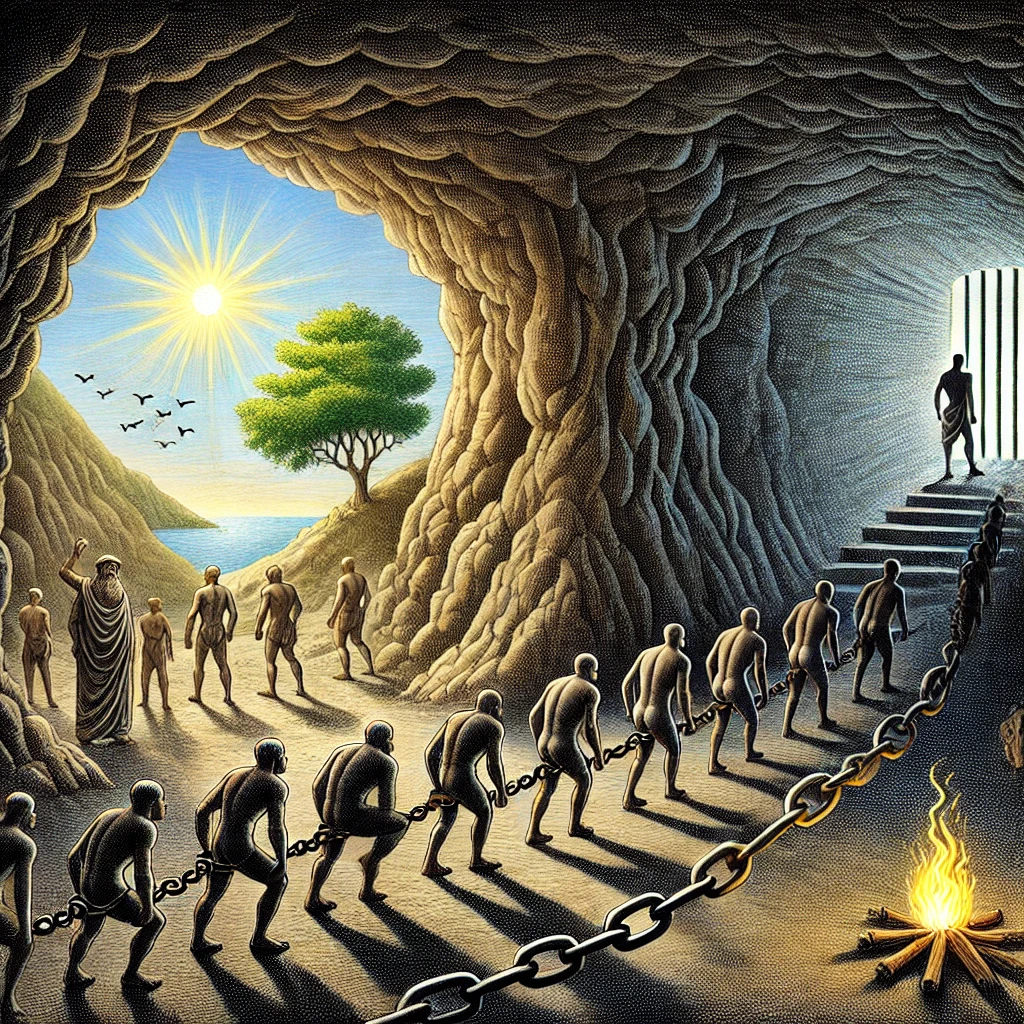Plato’s Allegory of the Cave: Reality and Illusion
Introduction
Imagine being trapped in a dark cave since birth, bound in such a way that you can only see the shadows cast on the wall in front of you. This is the reality for the prisoners in Plato’s famous allegory of the cave. Through this metaphor, Plato explores profound themes of perception, knowledge, and truth. But how does it apply to us today? Are we also prisoners of our own caves, mistaking illusions for reality? In this article, we will delve into the depths of Plato’s allegory and uncover the timeless wisdom it holds.
The Allegory Explained: Shadows on the Wall
The allegory begins with prisoners who have been chained inside a dark cave since childhood. They cannot turn their heads and are forced to look at the wall ahead of them. Behind them is a fire, and between the fire and the prisoners, there is a walkway where puppeteers cast shadows of various objects on the wall. The prisoners, never having seen the outside world, perceive these shadows as the only reality.
In Plato’s narrative, the shadows represent the perceptions of those who believe empirical evidence to be the ultimate truth. The cave symbolizes the limited understanding of reality based on sensory perception. The prisoners, unaware of their ignorance, take the shadows at face value, convinced that they are seeing the entirety of the world.
This is where Plato’s philosophy challenges us: Are we, too, simply observing shadows on a wall? Our understanding of reality is often shaped by what we see, hear, or are told. But how much of it is truly “real,” and how much is merely an illusion?
The Journey Out of the Cave: Enlightenment and Resistance
One day, a prisoner is freed and compelled to stand up and look around. Initially, he is blinded by the light of the fire, confused, and reluctant to leave the only reality he has ever known. As he is dragged outside the cave, the sunlight overwhelms him. Gradually, he begins to see the world beyond the cave—trees, rivers, animals—and finally, the sun itself, which illuminates everything.
The process of enlightenment, Plato suggests, is uncomfortable and disorienting. Leaving behind the familiar shadows for the bright light of knowledge is not easy. But as the freed prisoner adjusts to the outside world, he recognizes the truth: the shadows were mere illusions. True reality exists outside the cave, in the realm of ideas and forms.
This aspect of the allegory is crucial to understanding human nature. Even when confronted with new truths, people often resist, clinging to their comfortable yet misleading beliefs. This resistance to change and growth is not unique to the prisoners in Plato’s cave but is a recurring theme in human history and psychology. As the philosopher Friedrich Nietzsche famously said, “Sometimes people don’t want to hear the truth because they don’t want their illusions destroyed.”
Returning to the Cave: The Challenge of Sharing Knowledge
After his eyes adjust to the brightness of the outside world, the freed prisoner feels a sense of duty to return to the cave and liberate the others. However, when he re-enters the cave, his vision, now accustomed to sunlight, is impaired by the darkness. The other prisoners mock him, perceiving his struggle to see as evidence that leaving the cave was a mistake. To them, the shadows are still the only reality.
Plato uses this part of the allegory to highlight a fundamental truth: those who attain knowledge and wisdom often face resistance and ridicule when they try to share it. Just as the freed prisoner appears confused and disoriented in the dark cave, those who have glimpsed a greater truth may seem out of touch or strange to those who have never left their metaphorical caves. The reaction of the remaining prisoners reflects a common human response: fear and rejection of what we do not understand.
Modern Interpretations: Are We Still in the Cave?
It’s easy to dismiss Plato’s allegory as an ancient philosophical story with little relevance to modern life. But let’s pause and consider: What are the modern equivalents of the shadows on the wall? Could it be the endless barrage of information we consume daily from social media, news outlets, and entertainment? Are we prisoners to the narratives fed to us by algorithms and media conglomerates?
If Plato were alive today, he might argue that our “cave” is the digital world, where we are shown curated content that shapes our perceptions and beliefs. Escaping this modern cave requires questioning, critical thinking, and the courage to look beyond the surface.
Engaging with the Reader: Are You Ready to Leave the Cave?
Think about it: Have there been moments when you realized that something you believed in was just a shadow on the wall? It might have been a long-held assumption, a biased perspective, or even misinformation. How did you react when you first glimpsed the “light” of new knowledge? Were you open to it, or did you resist?
Leaving the cave, metaphorically speaking, is a personal journey that requires introspection and open-mindedness. It’s a process of peeling back the layers of illusion and striving for a deeper understanding of reality. As Plato himself said, “The unexamined life is not worth living.”
Conclusion: Embracing the Challenge of Truth
Plato’s allegory of the cave serves as a timeless reminder that reality is more than what meets the eye. The shadows on the wall may be comforting, but they are not the truth. Breaking free from our own caves, whether they are physical, intellectual, or emotional, is a daunting yet rewarding endeavor.
So, the question remains: Are you ready to step out of the cave and embrace the light of knowledge, even if it challenges everything you thought you knew? Remember, the journey to enlightenment is not about reaching a final destination but about continuously seeking, questioning, and growing.
FAQ:
1. What is the main message of Plato’s Allegory of the Cave?
The main message is that human perception is limited and often mistaken. Plato uses the allegory to show how true knowledge comes from understanding the forms and ideas that lie beyond sensory perception.
2. How does the Allegory of the Cave relate to modern life?
In modern life, the allegory can be seen as a metaphor for how media and technology shape our perceptions and beliefs, creating a “cave” of curated realities.
3. Why do the prisoners in the cave resist the freed prisoner’s knowledge?
The prisoners resist because they are accustomed to the shadows and perceive them as the only reality.
The freed prisoner’s experience seems unbelievable and threatening to their understanding of the world.














Post Comment